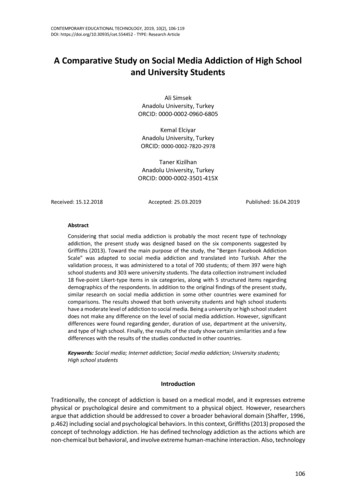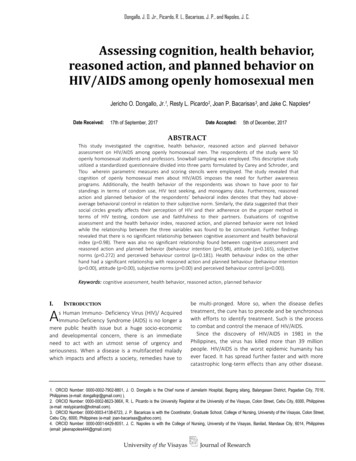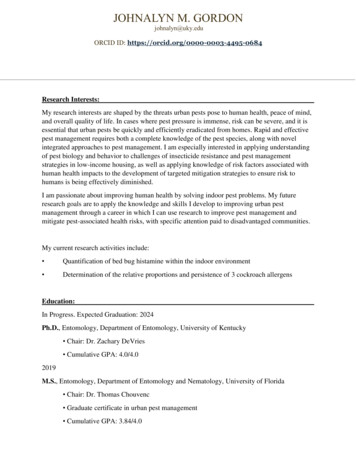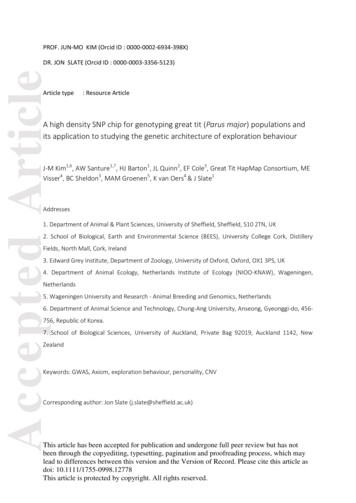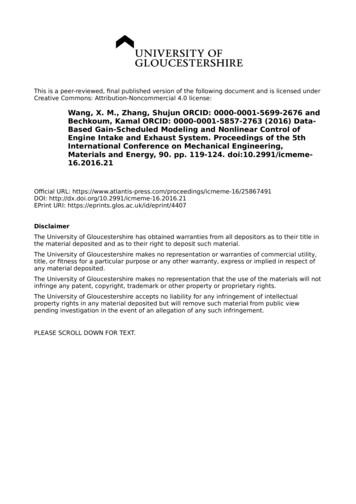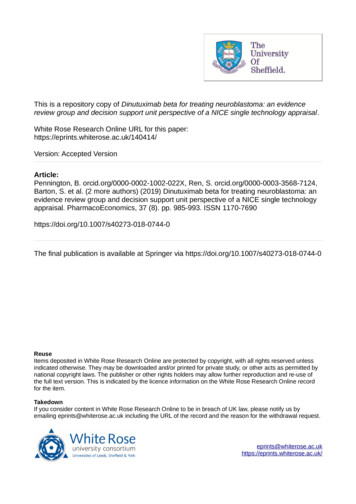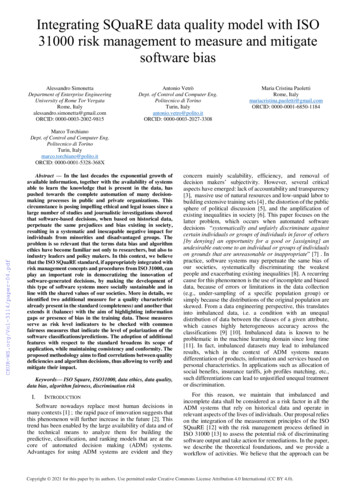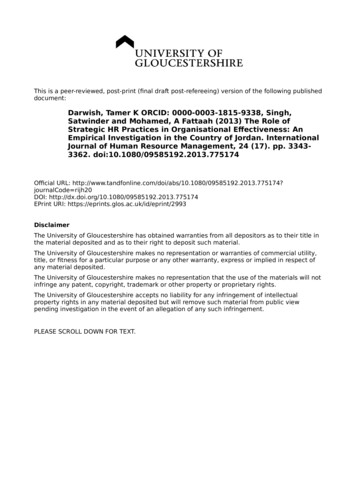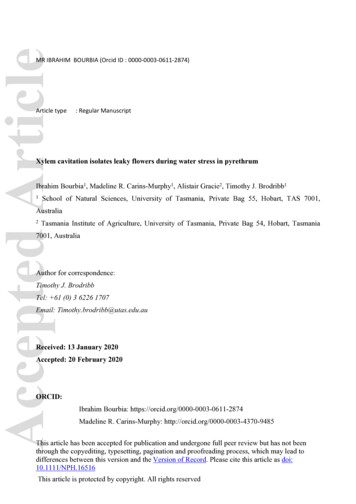
Transcription
Accepted ArticleMR IBRAHIM BOURBIA (Orcid ID : 0000-0003-0611-2874)Article type: Regular ManuscriptXylem cavitation isolates leaky flowers during water stress in pyrethrumIbrahim Bourbia1, Madeline R. Carins-Murphy1, Alistair Gracie2, Timothy J. Brodribb11School of Natural Sciences, University of Tasmania, Private Bag 55, Hobart, TAS 7001,Australia2Tasmania Institute of Agriculture, University of Tasmania, Private Bag 54, Hobart, Tasmania7001, AustraliaAuthor for correspondence:Timothy J. BrodribbTel: 61 (0) 3 6226 1707Email: Timothy.brodribb@utas.edu.auReceived: 13 January 2020Accepted: 20 February 2020ORCID:Ibrahim Bourbia: https://orcid.org/0000-0003-0611-2874Madeline R. Carins-Murphy: http://orcid.org/0000-0003-4370-9485This article has been accepted for publication and undergone full peer review but has not beenthrough the copyediting, typesetting, pagination and proofreading process, which may lead todifferences between this version and the Version of Record. Please cite this article as doi:10.1111/NPH.16516This article is protected by copyright. All rights reserved
Accepted ArticleTimothy J. Brodribb: https://orcid.org/0000-0002-4964-6107Summary: Flowers underpin plant evolution, genetic legacy, and global food supply. They areexposed to similar evaporative conditions as leaves, yet floral physiology is a product ofdifferent selective forces. We used Tanacetum cinerariifolium, a perennial daisy, toexamine the response of flowers to whole-plant water stress, determining if flowersconstitute a liability during drought, and how this species has adapted to minimize riskassociated with reproduction. We determined the relative transpiration cost of flowers and leaves and confirmed thatflowers in this species are xylem-hydrated. The relative water stress tolerance of leaves andflowers was then compared using xylem vulnerability measurements linked with observedtissue damage during an acute drought treatment. Flowers were a major source of water loss during drought but the xylem supplying themwas much more vulnerable to cavitation than leaves. This xylem vulnerabilitysegmentation was confirmed by observations that most flowers died while leaves wereminimally affected during drought. Early cavitation and hydraulic isolation of flowers during drought benefits the plant byslowing the dehydration of perennial vegetative organs and delaying systemic xylemdamage. Our results highlight the need to understand flower xylem vulnerability as ameans of predicting plant reproductive failure under future drought.This article is protected by copyright. All rights reserved
Accepted ArticleKeywords: flower hydraulic traits, hydraulic conductance, minimum conductance, vulnerabilitysegmentation, xylem embolismIntroductionFlowers have played a key role in the evolutionary success, diversification and rapid spread ofangiosperms (Regal, 1977; Soltis & Soltis, 2014), and are central to the production of food andother natural products. They require water to promote growth, maintain turgor, synthesize rewardsand attractants for pollinators, and thermally regulate sensitive reproductive organs (Nobel, 1977;Bazzaz et al., 1987; Patiño & Grace, 2002; Chapotin et al., 2003; Galen, 2005; Lambrecht et al.,2011; Roddy & Dawson, 2012; Roddy, 2019). For this reason it is likely that water limitation mayhave an important effect on the reproductive phase of plant growth, yet the water relations offlowers, and particularly their hydraulic function under drought, remains poorly understood(Zhang & Brodribb, 2017; Roddy et al., 2018). During water deficit, flowers can lose more waterthan leaves (Lambrecht, 2013), making them a potential liability to plant survival. Under suchconditions, the need to withstand water deficit can take priority over pollinator attraction, resultingin selection favouring traits that reduce floral transpiration (Feild et al., 2009a). Thus, it is notsurprising that, in addition to pollinator interactions, the water cost of floral maintenance and soilmoisture availability have been proposed to shape floral traits, such as size and longevity (Ashman& Schoen, 1997; Galen, 1999, 2005; Lambrecht & Dawson, 2007; Teixido & Valladares, 2014).In drought-prone habitats where plants often experience water stress during flowering, flowers aregenerally found to be small and short-lived (Primack, 1985; Galen et al., 1999; Herrera, 2005;This article is protected by copyright. All rights reserved
Accepted ArticleLambrecht, 2013). This evolutionary strategy has the potential to be a highly efficient way tominimize the floral transpiration budget, maintaining whole plant water balance and ensuringreproductive success in water limited environments (Galen, 1999; Teixido & Valladares, 2014).On the other hand, some studies have shown that many crop species abort flowers in response todrought stress (Guo et al., 2013; Muhl et al., 2013). This may have evolved as an active process,benefitting the plant by reducing transpiration when soil water is limited, or it may represent apassive process linked to inadequate water supply to the flowers. In either case, the possiblehydraulic mechanisms underlying flower damage during drought have been rarely studied (Zhang& Brodribb, 2017; Roddy et al., 2018).There is evidence to suggest that flowers of some species are weakly connected to the stem watersupply because they are hydrated predominantly by the phloem. This evidence includes the factthat flower water potential is less negative than that of bracts and subtending leaves (Trolinder etal., 1993; Chapotin et al., 2003; De la Barrera & Nobel, 2004), although stem water potentialwould need to be lower (more negative) than flower water potential to signal phloem water supply,and this information is not provided. However, recent work shows that in other species, flowershave lower water potentials than stems, high transpiration rates and high hydraulic conductance(Kflower); traits related with greater rates of water supply via xylem (Feild et al., 2009b; Roddy etal., 2016, 2018). Hydraulic connection with the rest of the plant xylem means that flowers mustoperate at low enough xylem water potential to draw water flow from the stem xylem, which mayexpose them to hydraulic failure due to xylem embolism during water stress (Zhang & Brodribb,2017; Roddy et al., 2018). Yet, knowledge about the relative vulnerability of flowers to xylemembolism compared with other vegetative organs within species and individuals is restricted to asingle study (Zhang & Brodribb, 2017) which showed that flower petals of two woody speciestended to be more vulnerable to embolism than leaves during drought. This observation alignswell with the vulnerability segmentation hypothesis suggesting that plants sacrifice shorter-livedorgans that require less energetic investment to avoid damage to longer-lived organs that requiremore investment and are critical for long term survival (Zimmermann, 1983). Although theimportance of leaf shedding associated with xylem cavitation has received much attention (Tyreeet al., 1993; Salleo et al., 2002; Brodribb & Holbrook, 2003a; Pivovaroff et al., 2014; Johnson etal., 2016; Hochberg et al., 2017), the physiology of flower shedding in the context of xylemvulnerability during water stress remains unknown.This article is protected by copyright. All rights reserved
Accepted ArticleA number of studies have found that stomatal closure precedes the onset of major cavitation instems and leaves (Cochard et al., 2002; Brodribb & Holbrook, 2003b; Martin-StPaul et al., 2017).When stomata close, the length of time taken to reach the critical water potential threshold for theonset of cavitation (safety margin) is determined by the water depletion rate of the soil or fromcapacitance within the plant via transpiration (McCulloh et al., 2019), which is mainly governedby minimum cuticular conductance (gmin) occurring through closed stomata and the plant cuticle(Martin-StPaul et al., 2017). However, compared with that of leaves, the cuticle of flower petals isa weaker barrier against water loss (Buschhaus et al., 2015). Thus, the relatively high minimumcuticular conductance of flowers suggests that during water stress, a plant bearing flowers mayhave a substantially higher rate of dehydration than a vegetative plant, thereby accelerating xylemwater potential decline and placing the whole plant at risk of cavitation. We hypothesise that“floral segmentation” may be selected under such conditions in perennials, whereby hydraulicdisconnection of flowers during the onset of water stress would provide a means of removingthese leaky structures, thus delaying water potential decline and the onset of hydraulic damage toperennial vegetative organs.In the present study, we comprehensively evaluate this “floral segmentation” hypothesis bymeasuring the interconnected relationships between water loss, water supply, hydraulic damageand flower survival in the perennial herb, Tanacetum cinerariifolium (Trevir.) Sch. Bip.(Asteraceae). Pyrethrum provides an ideal model system because it produces large numbers offlowers (300 flowers per plant on average) (Groom, 2003) from which minimum water loss (gmin)could be significant relative to that of leaves when scaled up to the whole plant during drought.We first quantified the efficiency of the hydraulic connection to flowers and their relativetranspirational losses compared with leaves after dehydration-induced stomatal closure. We thendetermined the relative susceptibility of flowers and leaves to vascular damage by constructingvulnerability curves for flowering stems and leaves using the optical technique (flowering stemswere used because they supply the entire inflorescence with water). Finally, based on these datawe dried plants to a water potential predicted to damage the majority of flowers but have littleeffect on leaves and evaluated the resulting mortality of both organs. The recovery of these plantsafter rewatering allowed us to evaluate the impact of tissue-specific xylem physiology on patternsof whole-plant drought-induced damage.This article is protected by copyright. All rights reserved
Accepted ArticleMaterials and MethodsPlant material and growth conditionsTanacetum cinerariifolium (Trevir.) Sch. Bip. (Asteraceae), commonly known as pyrethrum, is aperennial herbaceous daisy species cultivated for the production of pyrethrins, that are naturalinsecticides. Two-year-old pyrethrum plants (clones propagated by plant division) obtained from acommercial growing site in northern Tasmania were grown in 2-l pots filled with potting mix(medium 7 : 4 mix of composted fine pine bark and coarse washed river sand) using glasshousefacilities at the University of Tasmania from August (2018) to March (2019). Plants were watereddaily to full soil capacity and kept in a glasshouse regulated at 21 C : 18 C, day : nighttemperatures, under natural light. The relative humidity was c. 40% during the day on average.Hydraulic conductanceLeaf and flower hydraulic conductance was determined using the dynamic rehydration kineticsmethod (Brodribb & Cochard, 2009). All measurements were performed in the morning between9:00 h and 12:00 h. We sought to measure maximum hydraulic conductance in each organ, soplants were left unwatered for two days to generate a non-transpiring water potential that was inThis article is protected by copyright. All rights reserved
Accepted Articlethe range of values found in transpiring leaves at midday (between -1 and -2 MPa). Plants weretransported to the laboratory where they were enclosed in a clear plastic bag to allow the entry ofnatural light. Plant water potential was allowed to equilibrate for 30 min before measurementsbegan. Six leaves and eight flowers (with c. 5-7 cm long leafless flowering stem segments) werecut from three to four different plants (two leaves and two flowers from each individual) underfiltered, degassed water and immediately connected to a flow meter consisting of a capillary tubewith known hydraulic conductivity and a pressure transducer (Omega Engineering, Stamford, CT,USA) monitored with a data logger CR10X (Campbell Scientific, Logan, UT, USA). Thehydraulic flux into the leaves and the flowers (see Supporting Information Video S1) wasmeasured immediately upon connection to the flowmeter, and the readings were stored everysecond. Before the flow rate determination, water potential (Ψ) was measured using aneighbouring leaf or flower. The initial flow was determined by fitting an exponential curvethrough the first 20 s of the rehydration flow data and extrapolating back to the initial point ofexcision. Leaf and flower area (m2) were measured using a flatbed scanner in combination withIMAGEJ (National Institutes of Health, Bethesda, MD, USA). Hydraulic conductance (K) wasthen calculated as: K -I/ Ψ A, where I is the instantaneous initial maximum flow rate into theleaf or flower (mmol s 1), Ψ is the water potential measured before rehydration (MPa) which isequal to the initial hydraulic driving force across the tissue and A is the projected area of leaf orflower (m2). K values were averaged for each plant and then used to calculate the average for allindividuals.Flower and leaf xylem anatomy and hydraulic efficiencyXylem anatomical measurements were conducted on three petioles and flowering stems from threedifferent individuals (one petiole and one flowering stem from each individual). We sampledleaves and flowering stems carrying newly opened flowers of a similar size to those assessed forhydraulic conductance and optical vulnerability (c. 30 cm2 and 16 cm2 for leaves and flowers,respectively). Transverse cross sections were taken from the midpoint of the petioles between thepoint of leaf attachment and the first leaflet and c. 12 cm from the terminal end of the floweringstems (slightly below the small terminal leaf of flowering stems) (Fig. 1c,d). Cross-sections weremade with a sliding microtome (Leica Microsystems, North Ryde, NSW, Australia) and a BFS3MP Freezing Stage (Physitemp Instruments, Clifton, NJ, USA) at 25μm thickness. Sections werestained with 5% toluidine blue, mounted on glass slides in phenol glycerine jelly andphotographed using a digital camera (AxioCAM; Carl Zeiss, Germany) mounted on a compoundThis article is protected by copyright. All rights reserved
Accepted Articlemicroscope (DM1000; Leica Microsystems, Germany) with a 20 objective, and images wereanalysed using IMAGEJ. For each transverse section, a binary image was created, and the lumenarea of each vessel was automatically measured using the ‘analyze particles’ function. The totalnumber of vessels (n) in each section was counted and normalized by projected leaf and flowerarea (cm2) measured using IMAGEJ. The mean hydraulically weighted vessel diameter wascalculated for each section as Dh ( D4/n)1/4, where D (μm) is the vessel diameter calculatedfrom vessel area as the diameter of an equivalent circle and n is the number of vessels in thatcross-section (Tyree & Zimmermann, 2002). For each leaf and flowering stem the theoreticalspecific hydraulic conductance (ks(t), kg s 1 m-1 MPa 1) was then calculated based on theHagen‐Poiseuille equation (Tyree & Ewers, 1991) and normalized by organ area:𝜋𝜌 𝑛 𝑖 1(𝐷4𝑖 )𝜂128𝐾s(t) 𝐴where D is the vessel diameter (m), ρ is the fluid density (assumed to be 1000 kg m-3), η is theviscosity of water (1.002 10–9 MPa s-1 at 20 C) and A is the downstream projected leaf andflower area (m2).Stomatal closureTo determine stomatal closure point, whole plant diffusive conductance was monitored in threepotted plants without flowers during one drying cycle. The dry-down was conducted in a wellventilated air-conditioned room regulated at 21 C : 18 C, day : night temperatures, 14-hphotoperiod, under constant day light flux of c. 600 μmol m-2 s-1 at the leaf surface. Relativehumidity was maintained between 44 and 48%. Whole plant water loss was monitored daily usinga computer-interfaced balance. Before beginning the dry-down, pots were saturated and coveredwith a plastic bag to prevent evaporation from the soil and plants weighed continuously to anaccuracy of 0.01g (Model PG5002-S; Mettler Toledo, Columbus, OH, USA) every 1 minthroughout the whole drying cycle until midday water potential reached -4 MPa (c. 6 days). Plantwater potential was continuously measured by attaching an ICT psychrometer to a fully expandedleaf. Plant gs during drying was calculated as the loss of weight between measurements at midday(from 12:00 to 13:00 h) divided by the average mole fraction vapor pressure deficit (VPD) andnormalized to whole-plant leaf area measured at the end of the experiment. For each plant, asubsample of 20 leaves was scanned fresh and oven-dried to determine dry weight and specificThis article is protected by copyright. All rights reserved
Accepted Articleleaf area. The rest of leaves were oven-dried and weighed. Whole plant leaf area was determinedby multiplying the dry mass of all leaves by specific leaf area of the corresponding scannedsubsample. The stomatal closure point was determined as the water potential associated with an 88%(Ψgs88) reduction in stomatal conductance. Ψgs88 calculated was c. -3 MPa in pyrethrum.Leaf and flower diffusive conductanceWe measured the maximum diffusive conductance (gs-max, mmol m-2 s-1) of eight mature well-hydrated leaves and newly opened flowers from four individuals (two leaves and two flowers fromeach individual). Flowers and leaves were excised from plants between 11:40 h and 13:00 h(maximum water loss occurred at this time of day in the glasshouse). Short segments (c. 5 cm) ofpetioles and flowering stems (with no leaves) were included in leaf and flower measurements.Immediately following excision their cut ends were sealed with silicone grease and then organswere weighed every 30 s on an electronic balance ( 0.0001 g, model MS204S; Mettler Toledo,Columbus, OH, USA) under natural light in a glasshouse equipped with industrial circulation fansproviding rapid and constant air movements. The velocity of air flow was high enough tophysically move plant leaves. In addition, flower petals and leaves of pyrethrum are narrow, andleaves are highly dissected, resulting in very narrow effective leaf widths (less than 5 mm).Therefore, we assumed that a small amount of stirring would be enough to minimize the boundarylayer of both organs. The temperature and relative humidity (25.52 0.24 C, 48.48 2.72%) wererecorded every 1 min with an HMP45AC temperature/humidity probe (Campbell Scientific, Inc)and CR850 datalogger (Campbell Scientific, Logan, UT, USA). After five measurements, sampleswere scanned to determine projected area. Maximum diffusive conductance was calculated asfollows:𝑔𝑠 ― 𝑚𝑎𝑥 𝑊𝐿 𝑃𝑎𝑡𝑚𝑉𝑃𝐷where WL is the water loss rate (mmol m-2 s-1) calculated as the slope of mass (g) over time (s) andnormalized by the projected area of each organ (m2), Patm is the atmospheric pressure (101.3 kPa)and VPD is the vapor pressure deficit determined using the Arden Buck equation (Buck, 1981).()17.502 𝑇𝑅𝐻𝑉𝑃𝐷 1 ―(0.61121 𝑒 240.97100 𝑇)where T and RH are air temperature ( C) and relative humidity (%), respectively.This article is protected by copyright. All rights reserved
Accepted ArticleMinimum conductance (gmin, mmol m-2 s-1) was measured gravimetrically on twelve leaves andtwelve flowers taken from six different individuals (two leaves and two flowers from eachindividual) carrying between 15-40 newly opened flowers, after whole plants were dried down to 3 MPa, a water potential found to induce stomatal closure in pyrethrum. After sealing cut endswith silicone grease, water loss was measured by weighing the organs every 10 min using anelectronic balance ( 0.0001 g, model MS204S; Mettler Toledo, Columbus, OH, USA) in theglasshouse under similar conditions as gs-max. After five to six measurements, each organ wasrehydrated then scanned to measure its projected area. gmin was then calculated the same way as gsmax. Themeasured gs-max and gmin values were averaged for each plant and then used to calculate theaverage for all plants.Optical xylem vulnerabilityEmbolism formation was visualized simultaneously in leaves and flowering stems of six intactpyrethrum plants using the Optical Vulnerability Technique (Brodribb et al., 2016). Beforevulnerability measurements, plants were placed in plastic bags and left in the dark for c. 1 hr toensure stomatal closure and allow whole plant water potential equilibrium. Plants were thenremoved from the pots and their roots were rinsed with water to remove most of the soil. This wasdone to increase the rate of plant dehydration such that plants progressed from full hydration todeath within 5 days. Thus, the dehydration rate was sufficiently fast to accurately capture xylemcavitation, but slow enough to maintain water potential equilibrium within the plant and allow theplant to undertake normal metabolic adjustment during water stress.A stem psychrometer (ICT International, Armidale, NSW, Australia) was installed onto a centralregion of one flowering stem per plant to continuously monitor water potential (Ψ; MPa) as plantsdehydrated. The interface between stem and sensor was sealed with high-vacuum silicone grease(Dow Corning) to prevent moisture loss. In fitting the psychrometer, a region of epidermis, cortexand phloem c. 20 mm in length was carefully removed from all sides of the stem to expose theunderlying xylem. The prepared surface was rinsed with distilled water and dried to removepotential solute contaminants. The psychrometer was set to log water potential every 10 min andthe Peltier cooling time was increased from 5 to 20 s as the plants dried, ensuring a stable readingof the wet-bulb temperature. Leaf water potential was also periodically measured using aScholander pressure chamber (PMS, Albany, OR, USA) to verify the accuracy of thepsychrometer readings and validate the plant water status. Water potential measured bypsychrometer and pressure chamber were in good agreement in leaves that were undamaged byThis article is protected by copyright. All rights reserved
Accepted Articledrought. In several test plants psychrometers were fitted to both stems and leaves to confirm waterpotential homogeneity between tissues during dehydration. Leaf and flowering stem waterpotential measured by psychrometers were in good agreement (Supporting Information Fig. S1).Flowering stem vulnerabilityOne flowering stem carrying a newly opened flower was selected from each plant to visualizeembolism formation. A region in the centre of the flowering stem, 15-20 mm in length and 1-3mm in diameter was prepared by carefully removing the epidermis, cortex and phloem using asharp razor blade to expose the xylem. The exposed xylem was then covered with a thin layer ofhydrogel (Tensive Gel; Parker Laboratories Inc., Fairfield, NJ, USA) to improve light transmissionand reduce evaporation from the surface. The prepared flowering stem was then secured in acustom-built 3D-printed clamp fitted with a 20 hand lens magnifier, a small 8 mega-pixelRaspberry Pi camera, and white light-emitting diodes (LEDs) to illuminate the sample. The clampassembly was linked to a Raspberry Pi microcomputer programmed to acquire images in reflectivemode every 2 min.Leaf vulnerabilityUsing the same plants, intact fully expanded basal leaves from the most recent cohort were used tosimultaneously monitor cavitation events at the leaf level. Leaves were prepared by carefullyremoving trichomes from abaxial and adaxial surfaces using duct tape, and then secured on top ofa microscope slide with tape and topped with a coverslip. Three leaves were imaged with a LeicaDFC450 digital camera, using Application Suite software, mounted on a Leica M205Astereomicroscope (Leica Microsystems, Wetzlar, Germany) while three were imaged using aRaspberry Pi camera with clamp assembly as described above. The imaged area consisted of thedistal part of terminal leaflets (c. 2.5 cm2) and encompassed all vein orders including the midrib.However, only midribs and second order veins were used to construct leaf vulnerability curves. Inboth cases, the images were collected using transmitted light every two minutes. All plants wereleft to dry slowly in a dark room, and both leaves and flowering stems were imaged until nofurther embolism events were recorded for at least 12 hours (c. 5 days in total).Upon completion, image sequences were analysed by quantifying differences in light reflection(flowering stems) or transmission (leaves) caused by xylem cavitation using an image subtractionmethod in IMAGEJ (for details, see Brodribb et al., 2016 and www.opensourceov.org). Linearregressions were fitted to the psychrometer data (plant Ψ vs time) to derive the plant Ψ at the timeof each image capture. Ψ was then plotted against cumulative embolisms (% of total) to constructThis article is protected by copyright. All rights reserved
Accepted Articlethe optical vulnerability curves. Vulnerability curve data of each organ were fit to an exponentialsigmoidal regression as follows (Pammenter & Van der Willigen, 1998): Cumulative embolisms 100/ (1 exp (a (Ψ - P50))), where P50 is the pressure (water potential) causing 50% loss ofhydraulic conductivity and a is a fitted parameter related to the slope of the curve. P50 and a valueswere averaged for each organ. These averaged values were used to construct the meanvulnerability curve SE for each organ type.Drought treatmentWater was withheld from three potted plants (carrying between 12 and 17 newly opened flowers)until they reached a midday water potential of -4.5 MPa (c. 5 days). This water potential ispredicted by the leaf and stem vulnerability data to induce 90% and 15% loss of hydraulicconductivity in flowering stems and leaves, respectively. Psychrometers were fitted to theflowering stems of all three plants to monitor the progression of dehydration. Once the targetwater potential was achieved, plants were re-watered daily to full soil hydration and organmortality was assessed.Leaf death was assessed 4 days after rewatering and calculated as the percentage number of leavesthat were dead per plant and expressed as an average of three plants (The dead leaves werevisually identified as those in which more than 50% of the leaf blade area was brown). Flowerdamage was assessed in terms of petal turgor recovery and floral disc expansion. In flowers ofwell-watered plants, the petals remained turgid for between 26 to 30 days and flower senescencesigns such as shrinkage and wilting of petals were only observed after this period. Therefore,flowers that failed to recover petal turgor after only 5 days of drought were considered as damagedby water stress.In pyrethrum, the flower disc (area encompassing all disc florets) expands during the floweringperiod because of seed formation (Suraweera et al., 2017). Thus, the failure of the flower disc toexpand after drought was assumed to be due to a lack of seed formation. Flower mortality wasconsidered to have occurred if the floral disc diameter did not expand more than 15% betweenrewatering and the end of the flowering stage (26 days after rewatering). This value wasdetermined by measuring the disc diameter of a fourth well-watered control plant (carrying 18newly opened flowers) that shared the same flowering stage as the droughted plants during theexperiment. In this control plant, 83% of flowers increased their diameter more than 15% in theperiod between rewatering the droughted plants and the end of the flowering stage. The number offlowers damaged by water stress was divided by the total number of flowers per plant andThis article is protected by copyright. All rights reserved
Accepted Articleexpressed as an average of three plants. The floral disc diameter was measured using a digitalcalliper with measuring range at 0 300 mm and resolution 0.01 mm (Moore and Wright, IP54,Sheffield, UK).Whole plant floral and leaf areaTotal flower and leaf area per plant was measured for three randomly selected individualscollected from a commercial farm in northern Tasmania at peak flowering (majority of flowerswere at beginning of flowering stage). Plants were sealed in plastic bags and returned to thelaboratory where their roots were submerged under water to ensure leaf and flower hydration.Flower number was counted for each individual. Subsamples of flowers and leaves (about 10% ofthe total per plant) were scanned fresh for projected flower and leaf area and then oven-dried at70ºC until the mass stabilized to determine dry weight. All remaining leaves and flowers wereoven-dried and then dry weight recorded. For both organs, dry weight was strongly correlatedwith projected area (r 2 0.85). Therefore, the relationship between dry weight and areawas used to predict whole plant flower and leaf area from total plant leaf and flower dry weight.Statistical analysisDifferences between leaves and flowers were tested with Student’s t‐tests after testing fornormality and homogeneity of variances. All tests were made at a probability level of 5%. Resultsare presented as mean values standard error (SE). All analyses were performed using R version3.5.3 (R Development Core Team, 2019).ResultsPlants collected from the field carried between 200 and 400 flowers and their total floral areagreatly exceeded that of leaves. The mean percentage of total flower area was 54.03 5.31%higher than leaf area. The hydraulic conductance of flowers was 30% that of leaves (Kleaf) (Kflower 2.61 0.23 mmol m 2 s 1 MPa 1 vs Kleaf 8.59 0.19 mmol m 2 s 1MPa 1; P 0.05) (Fig. 1a).The hydraulic anatomy of the flowering stems and leaves was similar when normalized to flowerand leaf area. The vessel number per cm2 organ projected area (nflower 6.32 1.25 vs nleaf 5.50This article is protected by copyright. All rights
Keywords: flower hydraulic traits, hydraulic conductance, minimum conductance, vulnerability segmentation, xylem embolism Introduction Flowers have played a key role in the evolutionary success, diversification and rapid spread of angiosperms (Regal, 1977; Soltis & Soltis, 2014), and are central to the production of food and other natural products.
